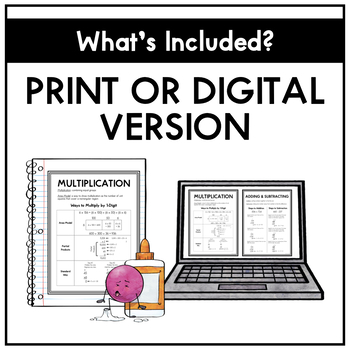4th Grade Math Reference Sheets
- PDF
- Google Apps™

What educators are saying
Description
OVERVIEW:
This resource includes 110 math reference sheets that were created to help students learn, review, and apply the Fourth Grade Common Core math concepts.
WHAT'S INCLUDED:
110 Reference Sheets: This resource includes 110 reference sheets that are related to the 4th Grade Common Core Standards. These reference sheets are great to print out and put on bulletin boards or place in student math folders, math notebooks, or homework folders! They can also be sent home to help parents understand the math concepts their child is learning at school.
Posters Included
- Place Value (3 Versions)
- Powers of Ten
- Comparing Values (2 Versions)
- Comparing Numbers
- Rounding Numbers (3 Versions)
- Adding and Subtracting
- Addition Properties
- Representing Multiplication
- Multiplication Properties
- Multiplication Chart (2 Versions)
- Multiplication Comparisons (2 Versions)
- Estimating Products (4 Versions)
- Multiplying by a 1-Digit Number (10 Versions)
- Multiplying by a 2-Digit by 2-Digit Number (4 Versions)
- Representing Division
- Division (3 Versions)
- Factors
- Multiples & Multiples Chart (5 Versions)
- Prime or Composite (4 Versions)
- Patterns (2 Versions)
- Representing Fractions
- Unit Fractions
- Fraction Bars (2 Versions)
- Comparing Fractions (3 Versions)
- Equivalent Fractions (3 Versions)
- Finding Common Denominators
- Decomposing Fractions (2 Versions)
- Adding & Subtracting Fractions (2 Versions)
- Fraction Forms (2 Versions)
- Adding Mixed Numbers
- Subtracting Mixed Numbers
- Multiples of Fractions
- Products of a Whole Number and a Unit Fraction
- Understanding Products of Fractions
- Multiplying Fractions (2 Versions)
- Multiplying Fractions by a Mixed Number
- Fractions & Decimals
- Equivalent Fractions: Tenths and Hundredths (4 Versions)
- Adding Fractional Parts of 10 & 100 (2 Versions)
- Converting Fractions to Decimals and Decimals to Fractions
- Comparing Decimals (2 Versions)
- Lines and Rays
- Types of Angles
- Types of Lines
- Geometry Terms (2 Versions)
- Classifying Shapes (3 Versions)
- Symmetry
- Degrees in a Circle (2 Versions)
- Drawing Angles
- Measuring Angles
- Join Angles
- Unknown Angles
- Measurement Tables (3 Versions)
- Line Plots
- Elapsed Time
- Area & Perimeter
- Area of a Combined Rectangle
2 Versions: This resource comes in both black and white AND as a Google Slides.
CUSTOMER TIPS:
Please go to your My Purchases page (you may need to login). Beside each purchase you'll see a Provide Feedback button. Simply click it and you will be taken to a page where you can give a quick rating and leave a short comment for the product. Each time you give feedback, TPT gives you feedback credits that you can use to lower the cost of your future purchases. I value your feedback greatly as it helps me determine which products are the most valuable for your classroom as well as I can improve past, current, and future products.




